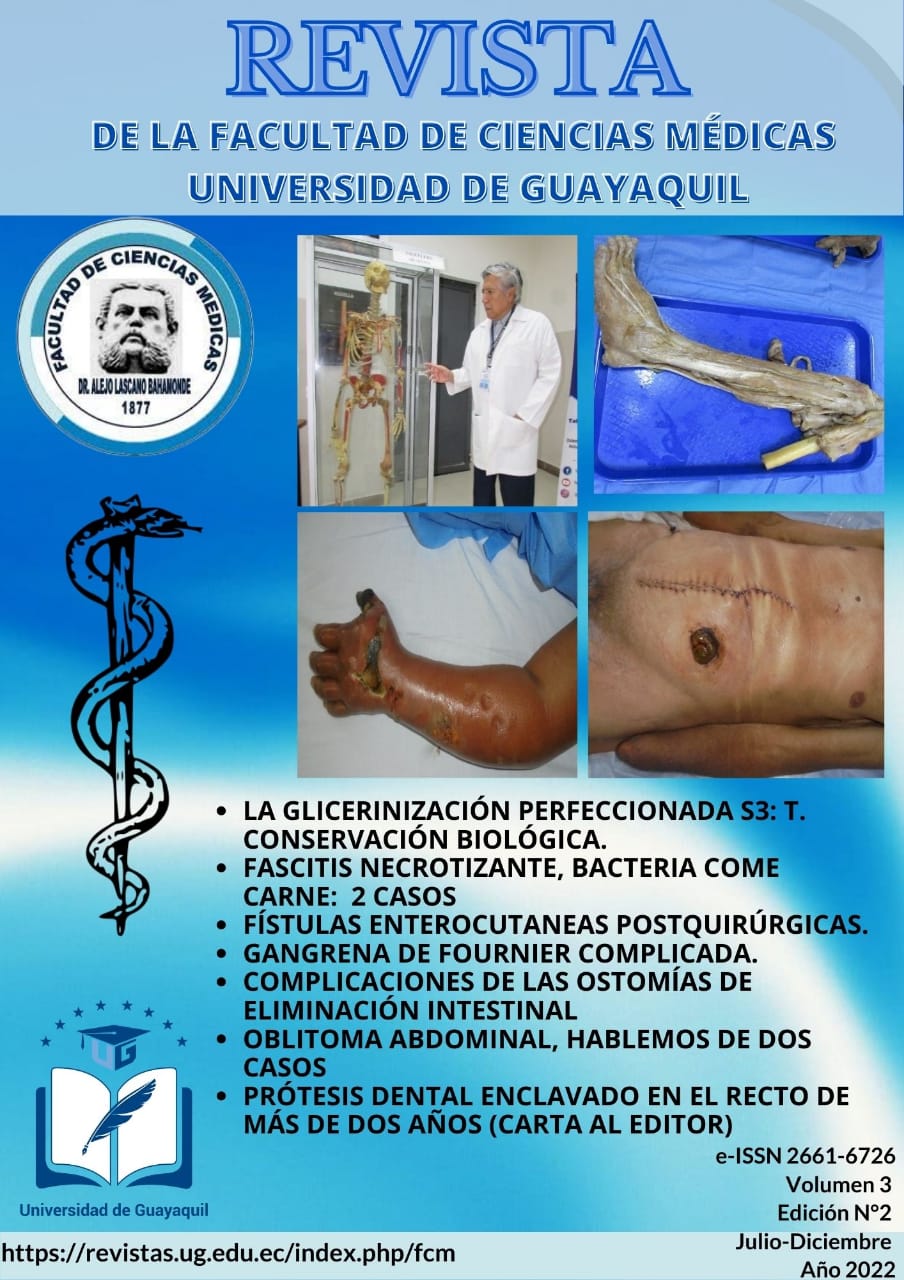Perfected Glycerinization S3: biological conservation technique that overcame the pandemic at the University of Guayaquil.
Our experience in anatomical preparations
Keywords:
Anatomical Preparations Workshop (TPA), human cadavers (real models)Abstract
The Anatomical Preparations Workshop (TPA) is considered a Human Anatomy laboratory of the Faculty of Medical Sciences of the University of Guayaquil; It works on the ground floor of the Rizzo building organized in four rooms occupying an area of approximately 120m2, distributed as follows: 1) Reception and administration room; 2) Work and conservation area; 3) Anatomical Museum and; 4) Auditorium for 50 people. The TPA is an unprecedented center in the country in this field, product of the need to improve academically on a permanent basis since its creation 15 years ago. The TPA, since its opening on September 7, 2007, has been dedicated to developing methodological innovations to strengthen the training of Health professionals from the Basic Sciences, which is basically synthesized with two purposes: to implement innovations in conservation and to contribute to the development of science and research in the field of Morphological Sciences. Since its inception and after having developed a necessary training process and extensive practice, the TPA has been dedicated to applying and innovating conservation techniques on biological tissues, providing a set of innocuous procedures that guarantee biological resources conserved for an indeterminate time to be used mainly in learning without affecting the university community. The TPA promotes conservation techniques for all biological tissues such as: osteotechnics, filling, corrosion, diaphanization and insufflation that have obtained favorable results. In this communication we highlight Glycerinization, a technique that has been perfected by using proven scientific and bioethical principles within the regulations on the management of waste enshrined in the Constitution and Health Code on the management of real models and complying with the agreement signed between the University of Guayaquil and the Sofia Ratinoff Asylum. The results obtained in this stage of the pandemic declared by the WHO on March 11, 2020 are reported, a situation that forced access restrictions and measures inherent to the health emergency that put the goodness of the technique to the test; We briefly highlight the versatility and obvious favorable performance of the processes applied in the TPA and the products that are available to the entire university scientific community.
TPA OBJECTIVES
- Develop biological conservation techniques under scientific, technical and ethical principles for the improvement of learning and higher education in all areas of Health.
- Apply their results in academic teaching processes with an emphasis on research.
- Communicate the advances and applications of conservation processes.
References
Ajileye, A. B.; Esan, E. O. & Adeyemi, O. A. Human Embalming Techniques: A Review. American Journal of Biomedical Sciences, 10 (2). 2018.
Alarcon, F. C. Conservación de piezas anatómicas en seco mediante el método de prives. REDVET. Revista Electrónica de Veterinaria, 6 (5), 1-7. 2005.
Anastakis, D. J., Regehr, G., Reznick, R. K., Cusimano, M., Murnaghan, J., Brown, M., & Hutchison, C.. Assessment of technical skills transfer from the bench training model to the human model. The American journal of surgery, 177(2), 167-170. (1999)
Balta, J. Y.; Cronin, M.; Cryan, J. F. & O'Mahony, S. M. Human preservation techniques in anatomy: a 21st century medical education perspective. Clinical Anatomy, 28 (6), 725-734. 2015.
Bustamante, M. F., Prieto Gómez, R. H. & Binvignat Gutiérrez, O. Preservación de Placenta Humana: Técnica Anatómica. International Journal of Morphology, 25(3), 545-548. 2007.
Coello, Cuntó R. (2013); Nuestra Experiencia en Preparaciones Anatómicas. Guayaquil, Ecuador. Universidad de Guayaquil.
Cundiff, G. W., Weidner, A. C. & Visco, A. G.. Effectiveness of laparoscopic cadaveric dissection in enhancing resident comprehension of pelvic anatomy. Journal of the American College of Surgeons, 192(4), 492-497. 2001.
Dixit, D.: Athavia, P. D. & Pathak, H. M. Toxic effects of embalming fluid on medical students and professionals. Journal of Indian Academy of Forensic Medicine, 27 (4), 209-211. 2005.
International Agency for Research on Cancer. La OMS considera cancerígeno el formaldehído. Revista Española de Patología, 38 (1), 62-63. 2005.
Holland, J. P., Waugh, L., Horgan, A., Paleri, V. & Deehan, D. J. Cadaveric hands-on training for surgical specialties: is this back to the future for surgical skills development?. Journal of surgical education, 68(2), 110-116. 2011.
Kang, P. S., Horgan, A. F. & Acheson, A. G. Try fresh frozen cadavers. BMJ: British Medical Journal (Online), 338. 2009.
McDougall, E. M., Corica, F. A., Boker, J. R., Sala, L. G., Stoliar, G., Borin, J. F.& Clayman, R. V. Construct validity testing of a laparoscopic surgical simulator. Journal of the American College of Surgeons, 202(5), 779-787. 2006.
Muñetón Gómez, C. A. & Ortiz, J. A. Conservación y elaboración de piezas anatómicas con sustancias diferentes al formol en la Facultad de Ciencias Agropecuarias de la Universidad de La Salle. Revista de Medicina Veterinaria, 1(22), 51-55. 2011.
Olivares, R., Labra, P. & Adaro, L. Técnicas anatómicas y métodos de conservación en anatomía veterinaria. TecnoVet, 11(3), ág-27. 2005.
Sharma, M., Macafee, D., Pranesh, N. & Horgan, A. F. Construct validity of fresh frozen human cadaver as a training model in minimal access surgery. JSLS: Journal of the Society of Laparoendoscopic Surgeons, 16(3), 345. 2012.
Shiwani, M. H. Fresh frozen cadaver: a model for laparoscopic surgery training. Journal of the College of Physicians and Surgeons-- Pakistan: JCPSP, 20(7), 425-6. 2010.





